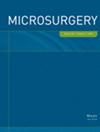Successive osteoseptocutaneous fibula transfers for jaws reconstruction are rare but important options. This study contributes patient-reported and clinical outcomes, as well as systematically reviews all existing reports.
All sequential fibula transfers performed by the senior author were reviewed from a prospectively managed database, including University of Washington quality of life (UWQoL). Systematic review was conducted in PubMed and Cochrane databases for similar publications.
Eighteen patients (average age 51.5 years) received sequential fibulas (mean 4.7 years between reconstructions). Secondary fibulas more often had benign indications (72.2% vs. 33.3%, p = .04), most commonly osteoradionecrosis (38.9%). At a mean follow-up of 30.5 months, the average interincisal distance increased from 21.8 to 27.6 mm, and 92.3% tolerated an oral diet following the second fibula.
Eight patients completed the UW-QoL before and after the second fibula, and three prior to the first fibula. Composite physical function was significantly decreased from 96.7 prefibula reconstruction to 63.3 following the first (p < .001) and 64.2 after the second fibula (p < .001). There were no differences in other domains.
The systematic review yielded six articles reporting 56 patients (mean 39 months between fibulas). Secondary fibulas were performed for repeat malignancy (45%) and osteoreadionecrosis (39%), resulting in elevated tube feeding from 20% following the first to 39% following the second, but overall high quality of life in two studies.
Sequential osteoseptocutaneous fibula reconstructions of jaws are often performed for benign indications such as osteoradionecrosis. Overall function and QoL are comparable with those following the first fibula transfer.


